Hail Damage to Asphalt Shingles | Introduction of Hail Damage to Asphalt Shingles | What Is Hail and How Does It Damage the Asphalt Shingles
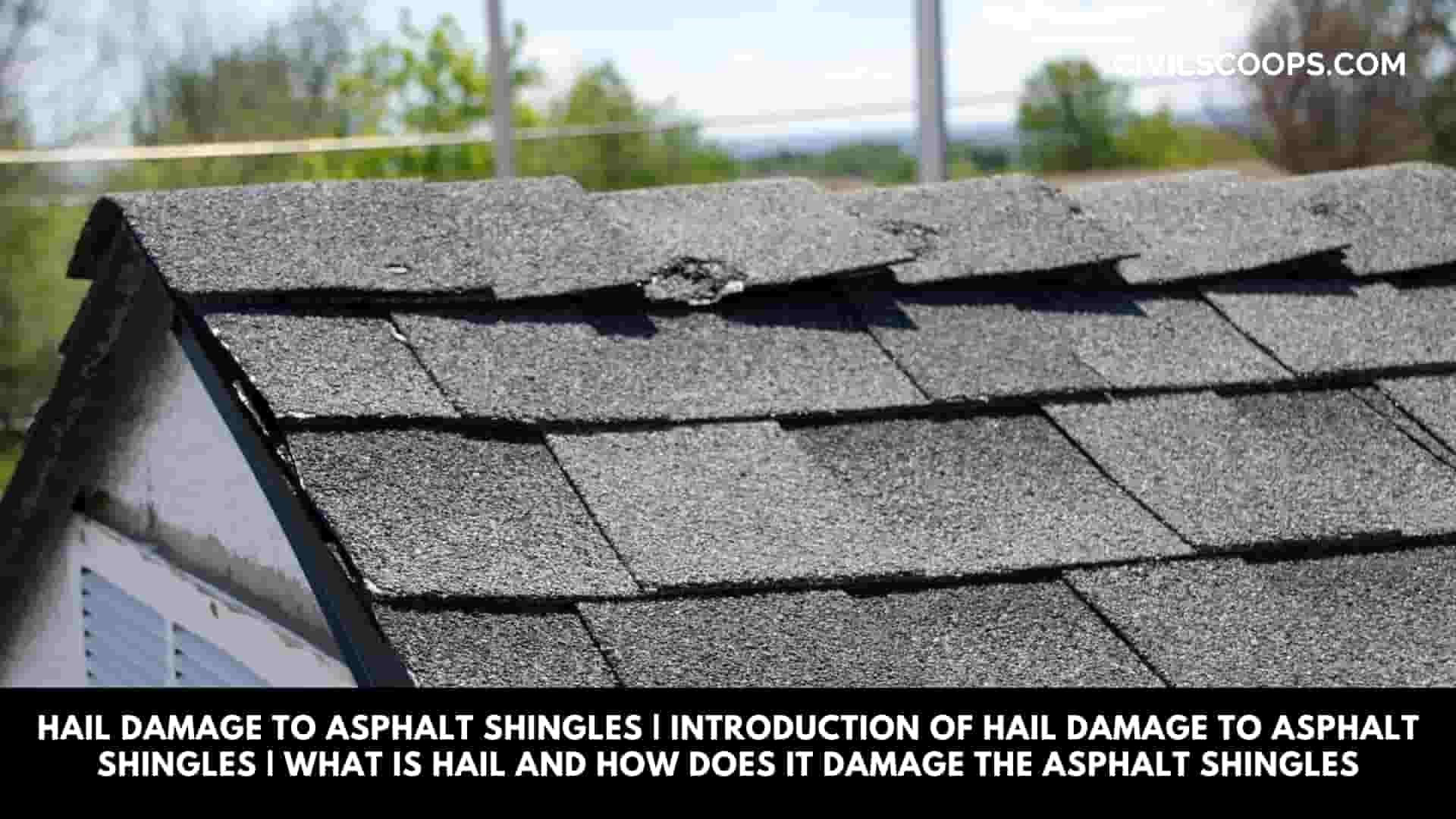
Table of Contents
Introduction of Hail Damage to Asphalt Shingles
As humans came into this world, at first, they started living in caves made from Rocks. The primary intention for living in caves was to protect themselves from adverse environmental conditions such as rain, storm, wind, etc; and also, to protect themselves from the attacks of wild animals.
Although caves fulfilled their primary intention, humans with their developing brains, soon realized the need for more.
They eventually grew aesthetic and architectural sense, and also the need for permanent belongings. As caves were not able to fulfill that, humans started thinking of building their own “homes” rather than living in caves.
So, they started gathering materials and started building homes using their concept. With progressing time, the homes they have built soon started facing various challenges.
As the primary material for construction was Wood, many a time, then the fire broke out in their house (as wood is very much susceptible to fire), while in some other times, the wood easily decayed due to presence in moisture, which as well as indirectly responsible for the growth of insects.
Thus, facing such challenges, the construction materials evolved as well. With the time of evolutions of construction, the concept of asphalt shingles is coming. There has a controversy arises that how asphalt shingles are damaged by hail and actually what hail damage looks like.
What Is Hail and How Does It Damage the Asphalt Shingles?
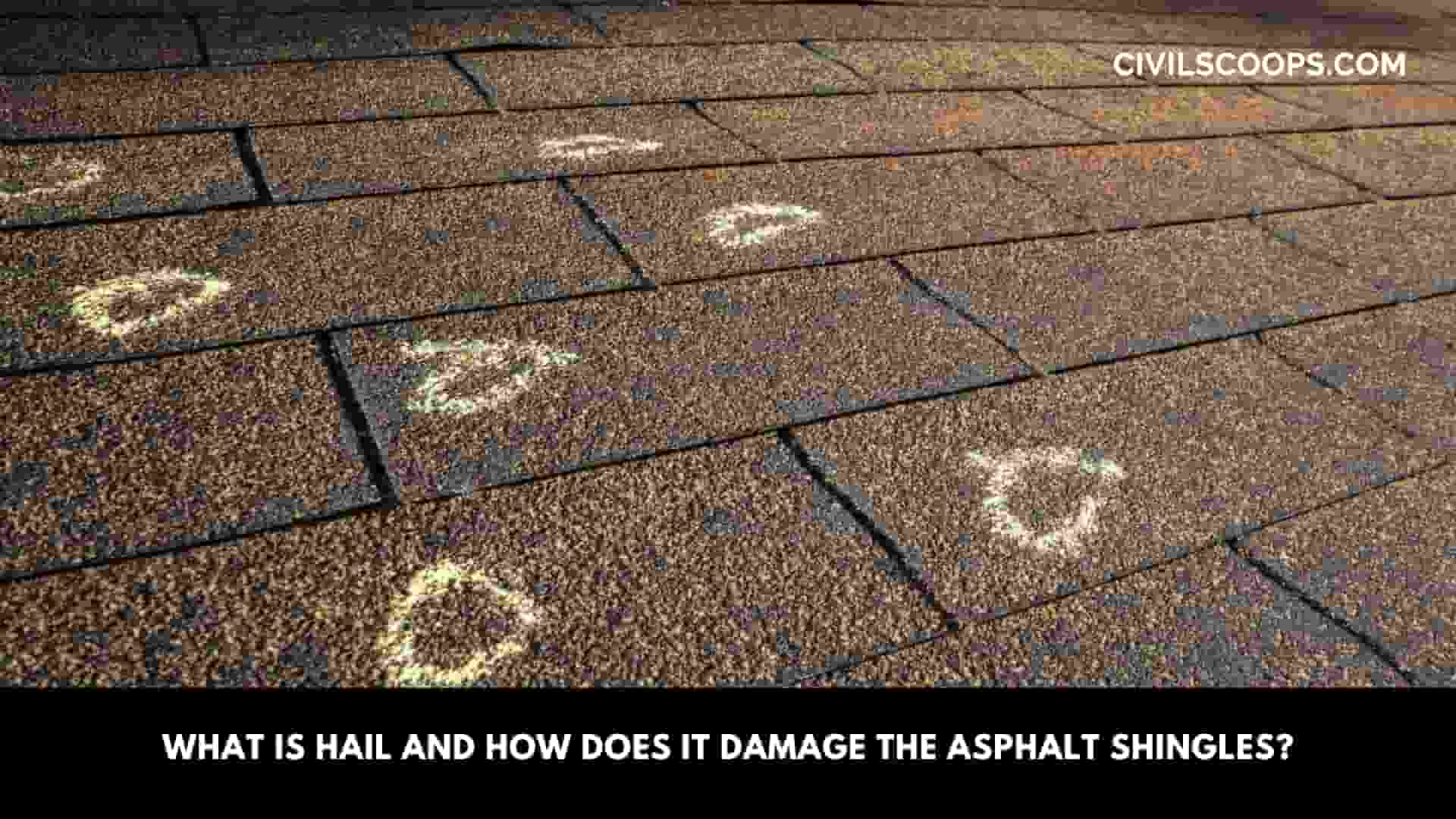
In simple words, Hail can be defined as a crystallized piece of snow. Many a time hail is confused with the ice pellets, but that’s often not the case. Ice pallets are generally solid precipitation of particles less than 5mm, which are generally spherical and circular, but rarely conical in shape.
Ice pallets are generally formed as raindrops fall through the cold air. The raindrops as they fall through cold air and clouds, soon lose their temperature and come in Sub-zero temperature.
As they come in Sub-zero temperatures, a thin layer of ice is formed converting the liquid raindrops. Many a time, while falling through the air, a fall in temperature might be witnessed, thus again converting the ice pallets into raindrops.
The size of ice pallets is far smaller than the size of hail, so it does not damage any roofs while falling. Many times, while falling through the thin layer of ice is again broken and again reverts to its original form, that is liquid rainwater. Thus, it can be said that hail is generally formed by keeping a lot of ice pallets together.
The formation of hail can be generally witnessed in cold regions. In those regions and all other regions as well, the air temperature rises as the height gets increased.
Thus, the temperature of the air at a higher place is larger than the temperature of the air at a lower place, keeping the geotechnical coordinates the same. As per the concept of transpiration, the warmer air gets upward, while the colder air gets downward.
So, the process starts from the evaporation of water due to continuous heat. As the water evaporates from the surface sources, it gets stored up in the lower layer of air, which is warmer.
Due to the up drift of warmer air (meaning warmer air gets higher), the rainwater stored in the lower layer of air gets upwards. As the temperature of the upper air, is much below the lower air, the raindrops generally fall below Sub-zero temperature and form thin ice.
As the weight of the ice is greater than the raindrop itself, it falls in the lower layer of air. As it falls in the lower layer of air, it generally melts into raindrops again.
Hails are generally the pieces of solidified raindrops, formed through the cycle of transpiration and evaporation, and have a size bigger than 5 millimeters.
And also, the hail damage the asphalt shingles by many ways like some specialist says it is torn, punctured and fractures on the asphalt mats. Some time by the reaction of hail on the asphalt roof shingles, the granules are dislodged from the asphalt math of the impact area.
Also Read: What Is Pitched Roof | 8 Types of Pitched Roof | Advantages of Pitched Roof
Hail Damage to Asphalt Shingles
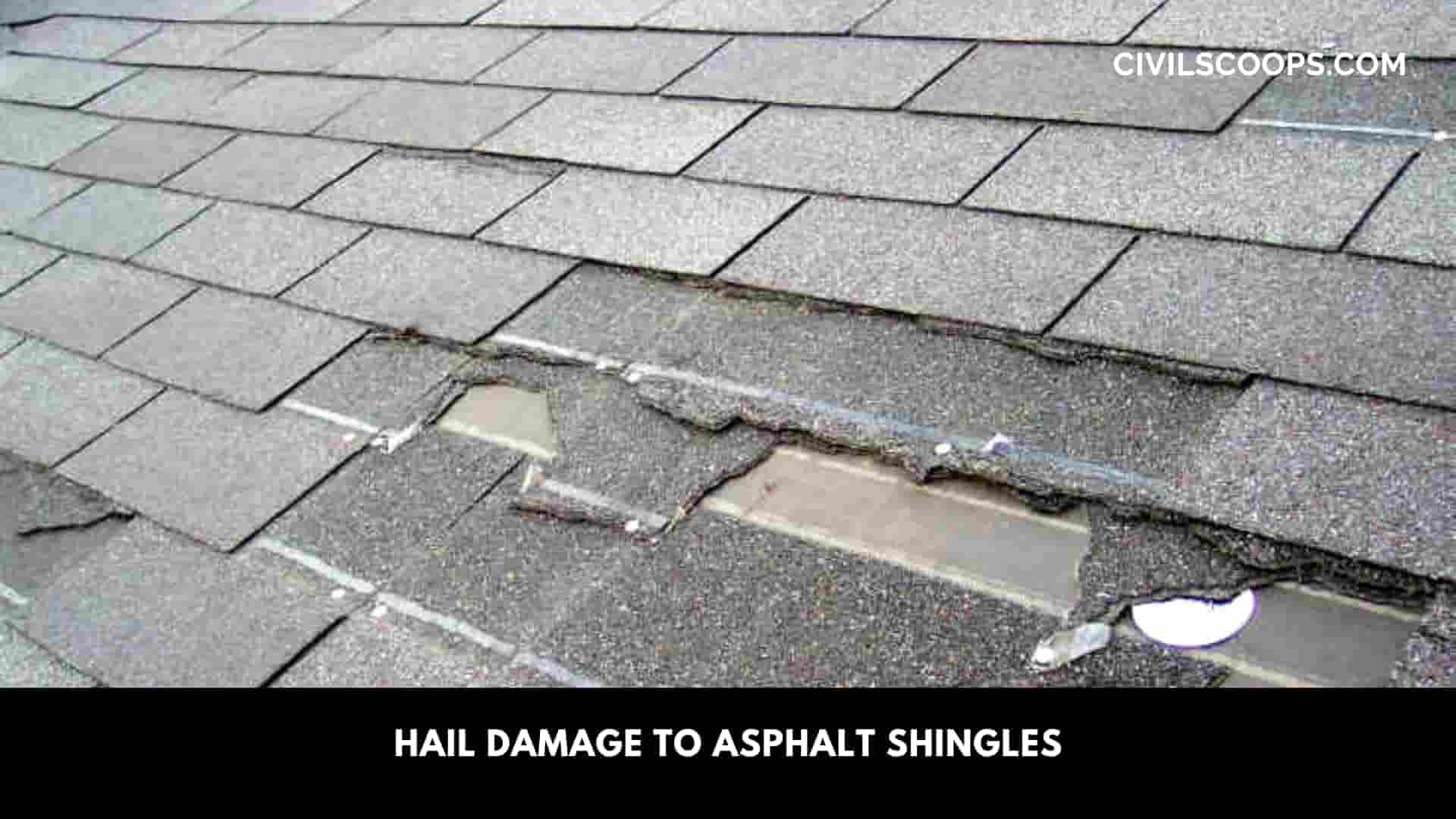
Here, two different types of examination are as follows.
1. Inspect the Exterior Shingles
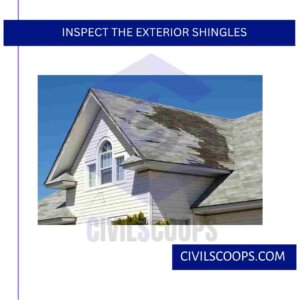
Due to storms, the roof of the houses is damaged widely because they are protected you as a front-line defense against tough outdoor weather conditions.
Then we check curling, granular loss, cracked shingles, missing shingles, etc. We need to hire a roofing contractor for inspection purposes or use a binocular.
2. Missing Shingles

Sometimes when a high wind storm has occurred then some asphalt shingles can be missing by the high wind and for this, some leaks create on the roofs. To avoid more serious water damage for leaks we should prevent the leaks by waterproofing seals.
Sometimes when there is seen a large number of shingles that are missing in this situation some homeowners are want to replace the whole roofing system.
Hail Damage of Asphalt Roof Shingles Components
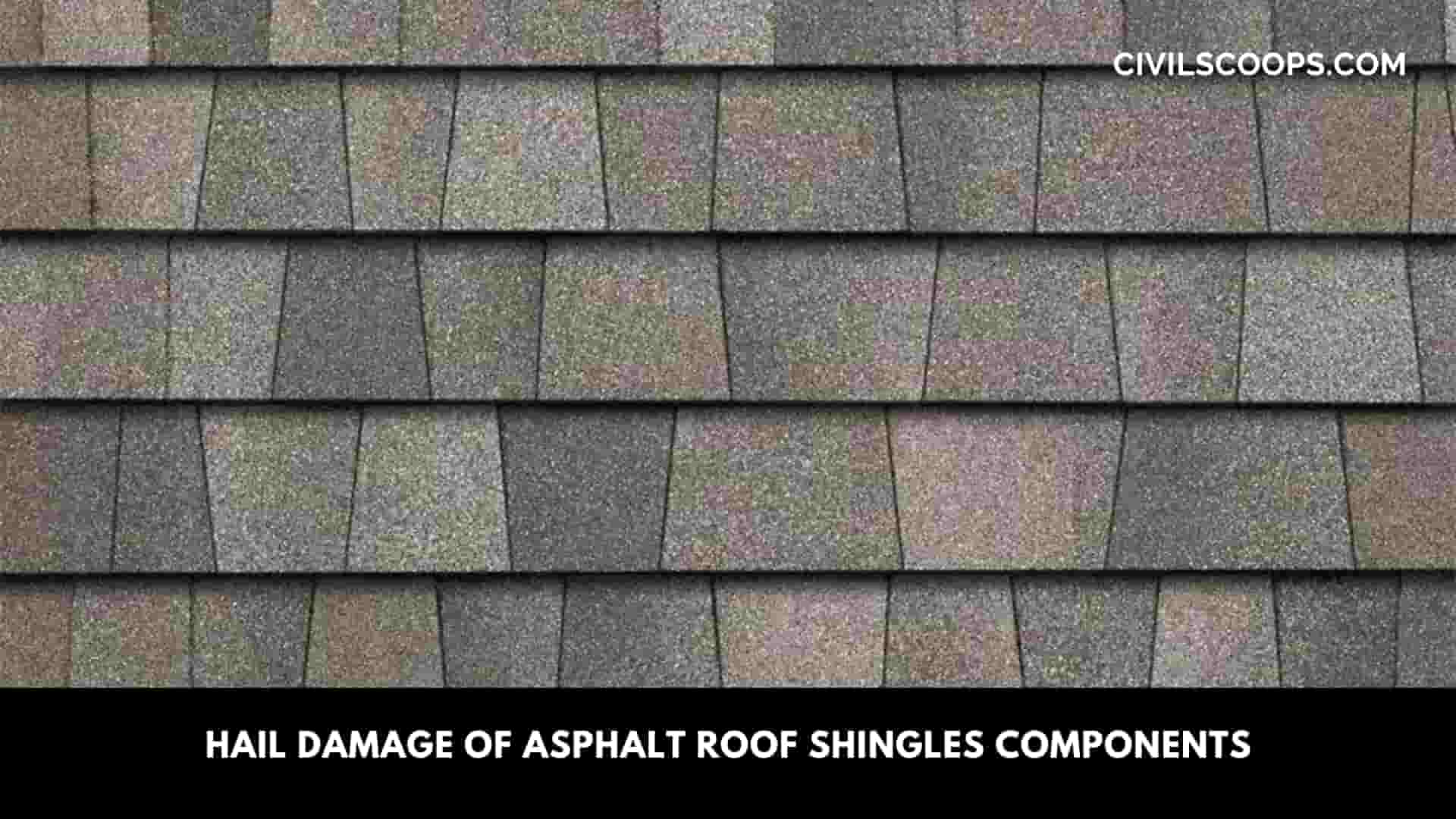
On the market, today asphalt roof shingles are affordable and one of the most common roofs covering materials. In the asphalt roof shingles, the base materials are glass-fiber that is an inorganic material or the other one is paper that is an organic material.
With the limestone power, of asphalt an asphaltic mixture of composed and also another mineral stabilizer like fillers.
On the asphalt shingles, surface granules are applied to provide weight, color and to block the deleterious effect of the sun on the underlying asphalt.
In this asphalt roof shingles with a ceramic material, the crushed stone coated granules are used. The ceramic is used to provide the color of the ceramic.
Generally, the weight of the granules is one-third of the asphalt shingles, and one-third is asphalt and the rest of one-third is filler material.
In the total weight of the asphalt shingles, the weight of the mat is a small fraction. In various shapes, sizes, athicknessesess the asphalt roof shingles are available in the market.
Generally, the cost of the asphalt shingles will be increasing the heaver or thicker of the shingles. In the constructions, the asphalt shingles which are mostly used that’s are laminated and three-tab varieties.
Hail Damage: Granule Loss Study
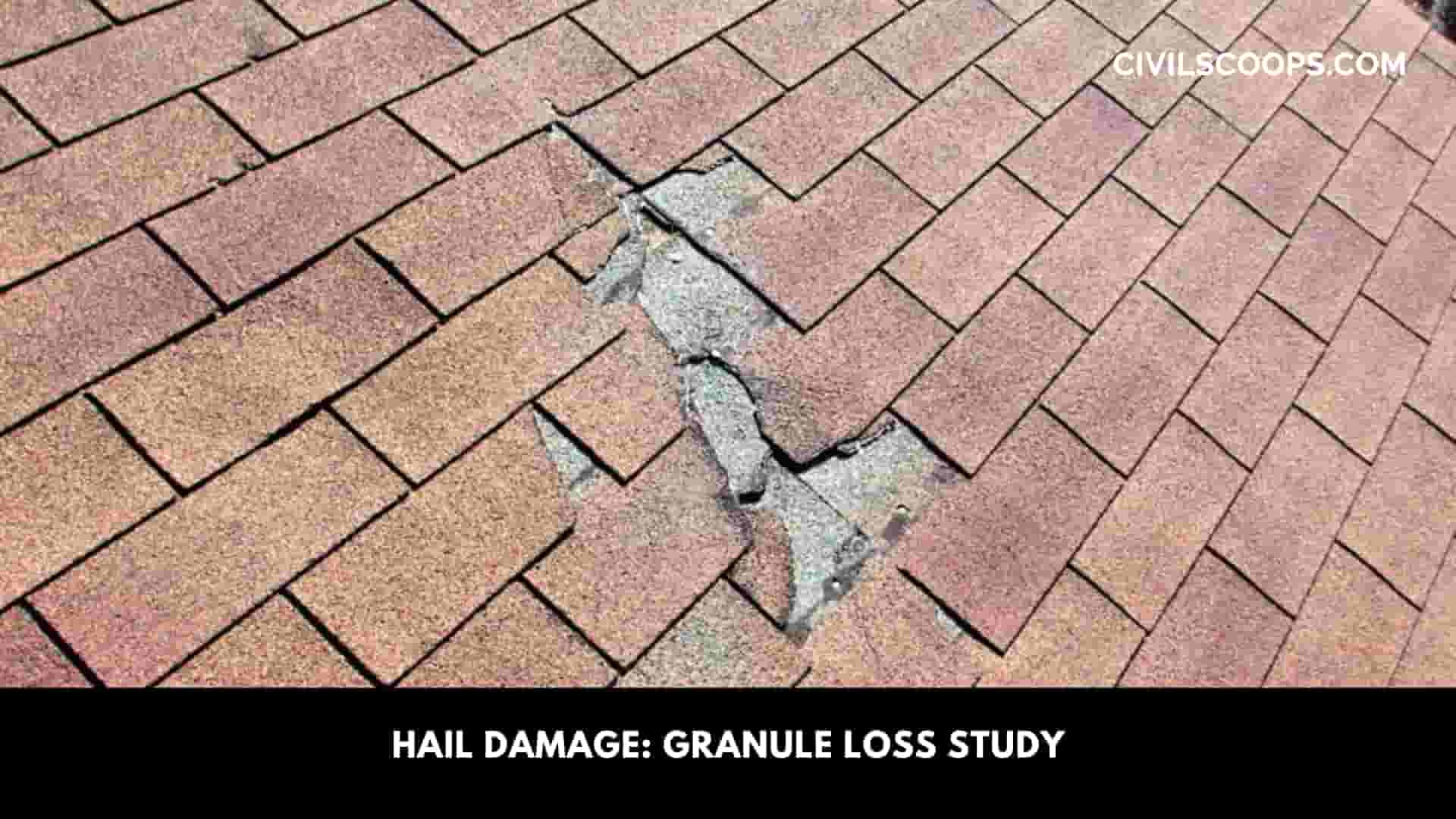
In the asphalt roof shingles, how many granules are removed on the affected area that’s affect the water-shedding ability or the service life of shingles, this process named by the author is a granule loss study on asphalt shingles?
With a wire brush, the quantities of removing granules are varying from new glass-fiber and three-tab mat shingles. After that for ten years, for the weather conditions in Texas and Dallas, the asphalt shingles are exposed naturally.
Approximately, 5, 15, 45, 70 % ( percent ) of granules are removed from the total amount of granules of the asphalt shingles. An upside-down shingle was installed when by the weather the asphaltic mat was exposed.
On the south-facing over wood conventionally the asphalt shingles were installed on a 4:12 pitch. AtAfterhe the study at intervals of ten years period the shingles were examined as well.
The exposed asphalt, in one year, had oxidized grey but on the surface of the shingles has no visible evidence of crack or erosion. The shingles to shed water after five years have oxidized of the exposed shingles area but the functions of the shingles did not affect.
Without granules shingles, surface erosion was visible on the shingles and the other hand had become glass fiber had become exposed. Without granules, after 10 years in the shingles, no significant change was noted. Due to erosion, the life longevity is a decrease of the asphalt shingles.
Hail Damage: Assessing Hail Damage

Assessing hail damage on shingles is a long process that’s occurred step by step examination of other things around the roof and the roof shingles. By using of test squares methodology, Herzog and Marshall presented to a roof how to quantify hail damage.
On each directional roof slope in test squares are counted the number of hail damaged shingles, and whether the roof slope is required that determines the number of hail damage that’s happened on roof shingles, by the use of DURA formula it can be replaced.
If there have no underlying support or have little especially along eaves, rakes, ridges, and valleys by hail damaged shingles are particularly susceptible. To be broken or chipped also are vulnerable to shingles edges.
Therefore, must be examined the entire roof carefully, when you examined the roof you can see if there are have many months of exposed asphalt it will provide a grey color surface and if it is recently exposed then it will provide a weathered or black surface.
You can say which one is new hail damage and which one is old hail damage by the color difference.
[su_box title=”FAQ” style=”default” box_color=”#333333″ title_color=”#FFFFFF” radius=”3″ class=”” id=””]
Hail Damage to Asphalt Shingles
Sometimes the impact from a hailstone can cause shingles to split and can only be seen when you look at the backside of the roof shingles. It’s best to call a roofing contractor to assist in this type of inspection, as they can lift up, examine and re-seal shingles as needed.
What Is Hail?
Hail impacts to your roof often cause damage, where you can spot bruises on the shingles and a significant loss to your roof’s granules. The damage can look like it misaligned your shingles or just left a few marks.
What Is an Asphalt Shingle Roof?
An asphalt shingle roof is the most common type of roof you see on homes today. It’s a roof system made primarily out of asphalt shingles and other asphalt roofing components. There are three types of asphalt shingles to choose from: 3-tab, dimensional, and luxury.
How Long Does the Average Asphalt Shingle Roof Last?
General life expectations of roofing materials:
Asphalt Shingles (3 tab Shingles): 15 to 20 years. Asphalt Architectural Shingles: 20 to 30 years. Built-Up Roof: (tar and gravel) 10 to 20 years.
Where Does Hail Form?
Most hailstones do not have smooth edges, which can impact the type of damage they cause. Building materials – Building materials absorb hail impacts differently. For example, hail can cause dings in aluminum siding, gutters or asphalt shingles, whereas it can crack vinyl siding or wood shakes.
What Are Asphalt Shingles?
An asphalt shingle is a type of wall or roof shingle that uses asphalt for waterproofing. It is one of the most widely used roofing covers in North America because it has a relatively inexpensive up-front cost and is fairly simple to install.
How Does Hail Damage Roof?
Hailstorms can cause serious damage to a roof. The impact from a hailstone can bruise or crack roofing shingles, potentially leading to water damage in your home.
How Much Hail Damage to Replace Roof?
When a replacement is justified, they will do a test square which is a 10′ by 10′ area. Each carrier is different on how many hail hits needs to be in that test square. On average, it’s anywhere from 7 to 10 hits. These factors of hail hits are based on the age of the roof as well as the pitch of the roof.
How Does Hail Damage a Roof?
Hard hail impacts or high winds can grip the shingles and cause cracks. This can lead to exposure and tears, leaving your roof with bare spots. Cracked shingles cannot effectively protect your roof from the weather.
How Do You Know If Your Roof Has Hail Damage?
More signs of hail damage to your roof are dings/dents/splatter marks to your roof vents, gutters, roof flashing, and other roof penetrations. If your roof has any of the damage listed above, it’s a good chance you’ll have a homeowners insurance claim.
What Is Hail Damage on a Roof?
Hail damage on a roof refers to the destruction or impairment caused by hailstones during a hailstorm. Hailstones are balls or irregularly shaped chunks of ice that are formed when updrafts in thunderstorms carry raindrops upward into extremely cold areas of the atmosphere, causing them to freeze. These ice pellets can vary in size, ranging from small pebbles to larger chunks.
Is Hail Damage to Roof Covered by Insurance?
Whether hail damage to a roof is covered by insurance depends on the specific terms and conditions of your insurance policy. In many cases, standard homeowner’s insurance policies do cover hail damage, along with other types of storm damage. However, it is important to review your policy or contact your insurance provider to understand the details of your coverage.
What Size Hail Is Damaging?
To be considered severe, hail stones must be at least 3/4 inch in diameter. Small Hail – Hail less than 3/4 inch in diameter (from the size of peas to marbles). Large Hail – Hail from 3/4 inch to 1 3/4 inch in diameter (from the size of nickels to golf balls) causing minor damage.
What Type of Roof Is Best for Hail?
Hail-resistant roof shingles and metal roofing materials are both recommended for areas that are prone to hail. Asphalt shingles with a UL2218 rating of Class 3 or Class 4 are considered highly resistant to hail. Slate tiles are also effective against hail.
What Is Hail Damage to Shingles?
Dents or Impact Marks on the Roof
Hail damage doesn’t just look bad. It causes shingles to lose some or all of their protective granules and coverage. Upon close inspection, you can see areas where the granule layer is scraped off or has a hole on its surface.
[/su_box]
[su_note note_color=”#F2F2F2 ” text_color=”#333333″ radius=”3″ class=”” id=””]
Like this post? Share it with your friends!
Suggested Read –
- Water Damage from Water Heater | How to Repair Water Damage from a Leaking Water Heater
- Repairing Water Damaged Wall | How to Repairing Water Damaged Wall | How to Fix Water Damaged Wall
- Roof Leak Detection | What Can a Leaking Roof Due to My Home | What Are the Symptoms of a Leaking Roof | What Causes a Roof to Leak
- Built Up Roof with Gravel | Why Do They Put Gravel on Flat Roofs | Purpose of Gravel on a Flat Roof | Added Benefits of Bur Flat-Roof Gravel
- Residential Roofing | Which Residential Roof Type Is Best for You | Types of Roofing | Find the Right Roof Type for Your Home Based on Design and Price
[/su_note]
Originally posted 2023-07-08 12:51:30.
